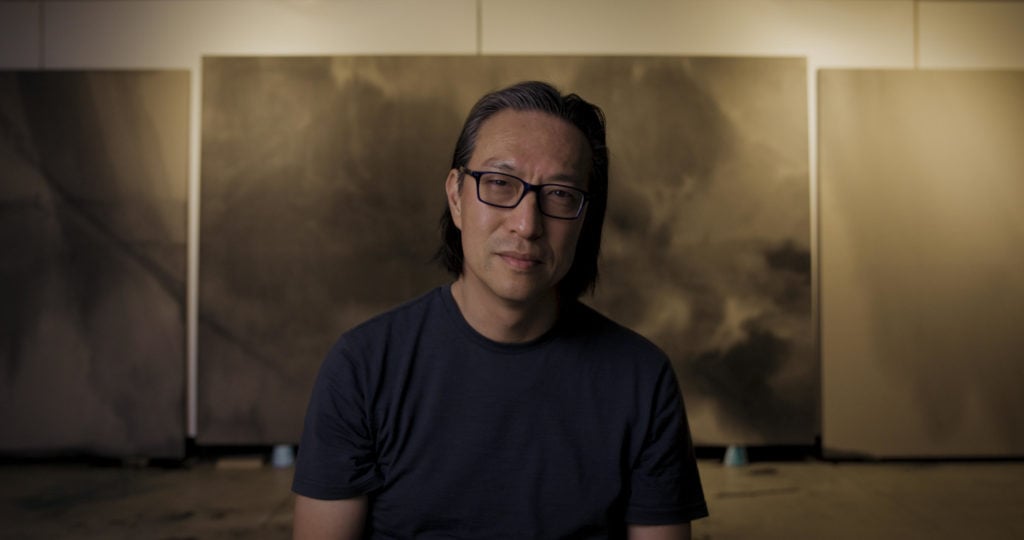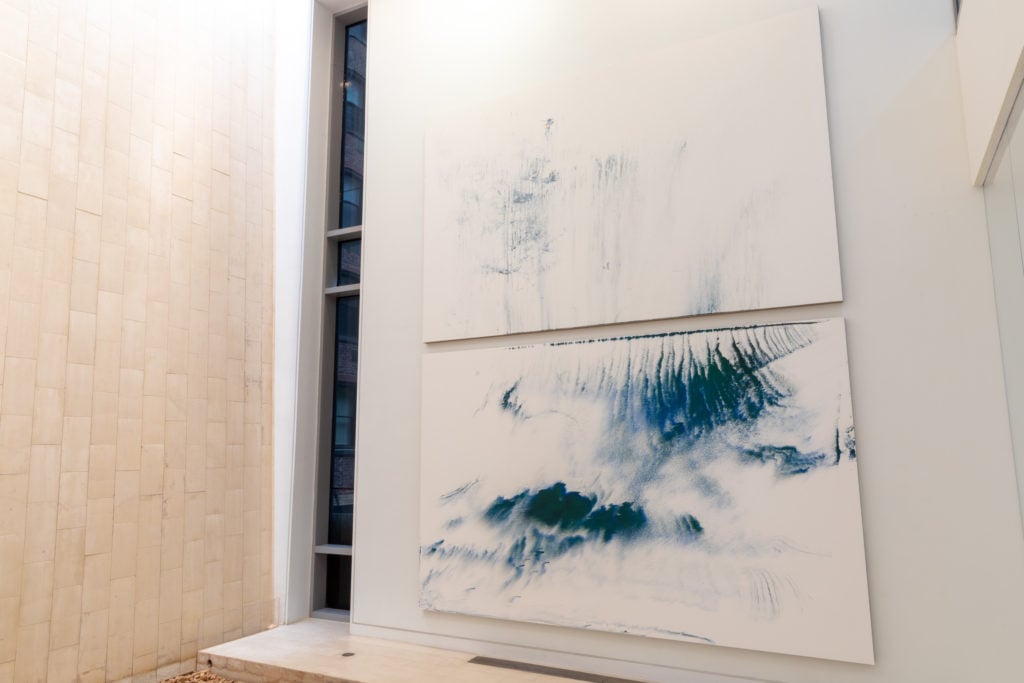‘Art-Making Is an Act of Hope’: How Japanese Artist Makoto Fujimura’s Paintings Became an Homage to His Recently Deceased Mother


Noor Brara

Japanese-American artist Makoto Fujimura thinks we’re out of touch. The culprit, he says, is technology: because we’re constantly plugged in, we never know which way is up. That’s where his work steps in. He wants “to help re-calibrate what makes us human.”
Fujimura is a painter who describes his work as a meeting between Abstract Expressionism and the traditional nihonga style (literally translated as “Japanese-style art”), in which artists use ingredients like sumi ink and pulverized oyster shell. His paintings, which are often inspired by nature, are also often speckled with gold leaf, which Fujimura describes as a nod to his Christian faith. His work is best appreciated, he says, if viewers devote at least 20 minutes to a painting.
“Probably like you, I’ve felt a great need to take a break from this pace every once in a while and step into a slower dimension of time,” the New York Times columnist David Brooks wrote in an article about Fujimura’s work. “[Fujimura’s] paintings are very good for these moments.”
On the occasion of a new exhibition of his work at Kate Shin’s Waterfall Gallery, titled “Sea Beyond“, we spoke with the artist about his work, his love of “slow art,” and the role of the artist in contemporary society.

Fujimura’s “Walking on Water” (Grace & Waves). Azurite On Kumohada. Photo courtesy Alex Sims.
Tell me a little bit about “Sea Beyond”.
“Sea Beyond,” the title, came when I was working on a series of prints last November with Kate Shin at Lichtenstein Studios. When I saw the images, I said to myself: “This is ‘See Beyond.’” They were visceral works, and made me feel like I could see beyond my own frame of reference into another, other-wordly place. But then I realized that there was this other side of it that had everything to do with my studio in California and Newport Beach. It’s got a beautiful sea horizon that I love to stare at, where I can really “see beyond.”
In December, I was working in California, and I had these new canvases, which I knew I was going to cover entirely in oyster shell, which is, in some sense, very slow and difficult to use, but in other ways, it has a vast textural range that you can do so much with. As I was working on it—I was about 80% done—I received the news that my mother had passed away. I was at Newport Beach studying the horizon for the work when I heard. So I walked out to the ocean while pondering this image before me and all of a sudden felt I needed to find out where exactly this point of “sea beyond” was, in the world. I looked up that particular vantage point and expanded it in Google Maps, and saw that the view I was looking at exactly lined up with Kamakura, Japan, where I grew up and where my mom would take me to the beach as a child.
So Sea Beyond became an homage to my mother. I think my intuition was way ahead of me, as usual, and I was depicting something that I would need for myself. My mom had heavy dementia, and I’d sort of been saying goodbye to her for the last ten years, but still, she was physically well, so her death came as a shock to me.
So the works, from that point, became a kind of elegy to her?
Yeah. When I got back to the studio, I looked at the oyster shell canvases—they were going to form an altarpiece triptych, with the middle one raised—and I felt that something wasn’t quite right. When you lose both your parents, you cross this threshold and something changes. The works didn’t quite reflect that shift for me. I was looking at these canvases, which I had painstakingly covered in layers of oyster shell, and said to one of my assistants, “I want to do something crazy. You’re going to think I’m crazy.”
I turned the middle panel upside down. So when you look at it, you can actually see that the middle part looks different from the other two. But it was absolutely right. It was like, “This is how I feel.” The world, when you’re breathing, can sometimes seem upside down, but when you meet somebody on the other side, and you get their perspective, it flips the script for you. I told Kate this, and she said, “Okay, let’s do a show and dedicate it to your mother.”
I know that you are a religious person. Did you find yourself turning to religion more after your mother passed away, to reaffirm your path or purpose as an artist?
You know, what’s funny is that my mother didn’t raise me Christian, even though her parents were, which is rare in Japan. So my mother didn’t push me to choose Christianity, I just became a Christian because of various influences in my own life. I guess I’m religious, but what’s more important is that God opens up something in an artist in a unique way, if you are religious. I feel commissioned to help people to see and trust the spiritual, intuitive, holistic sides of human beings that are sometimes difficult to access. To me, that’s what Jesus represents; he’s the only human, really, who walked the earth with his spirit intact, without this kind of mask that we all wear. So that authenticity is what artists try to express, really, and it takes incredible integrity to do that.

Works from Fujimura’s “Sea Beyond”. Photo courtesy Waterfall Gallery.
How do you feel about the fact that we are in this incredibly divisive time, and how do you think artists should or shouldn’t be addressing it?
Recently, I was interviewed by PBS about Mark Rothko’s paintings because they wanted to talk to someone who’s been influenced by him. It was supposed to be a ten minute interview, and it went on for an hour, because I said something that triggered an understanding in the interviewers, which was that Rothko’s paintings are about standing in proximity to a kind of ominous, “otherized” world. But I see hope in that unfamiliarity. And the reason is, it makes me want to go to my studio and paint again. He pushes me into my own journey of, “What can I do?” And in order to do that, you have to view every act of art-making as an act of hope. It doesn’t matter if it’s Francis Bacon or Lucian Freud, it’s bringing something into reality that hopefully someone will see. And that, to me, is so important. Art has become a self-expression driven entirely by ego, but to see the world only how I see it is incomplete. You surely can’t believe that yours is the only perspective there is; if you lived alone on an island, why would you create? You’re creating in part because there are others around you.
What we need is art that brings you outside of yourself, and pulls you to look at the horizon and to see beyond. And that’s kind of my hope, that not just me, but other artists and writers and singer-songwriters will use our superpowers to really help people, and to give them a language and a way to have the courage to look up. Because I think we when we do—that’s the greatest miracle—we can share in our differences.